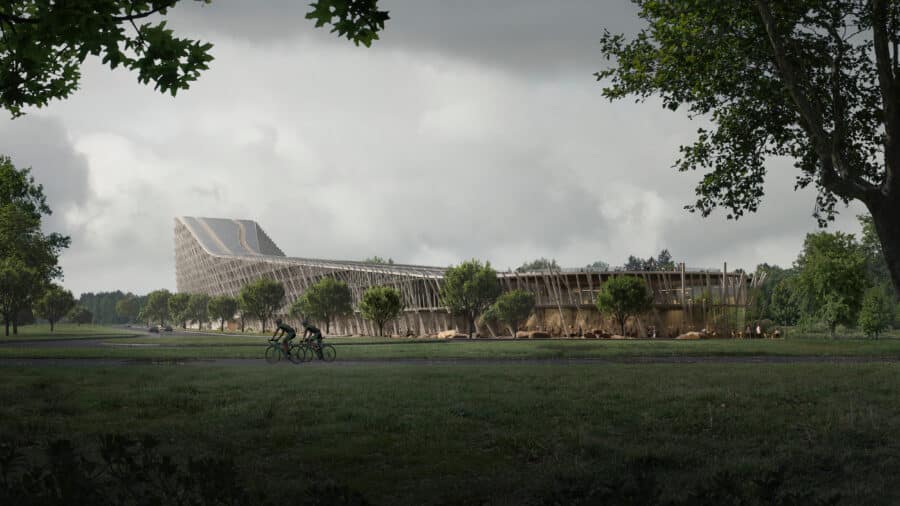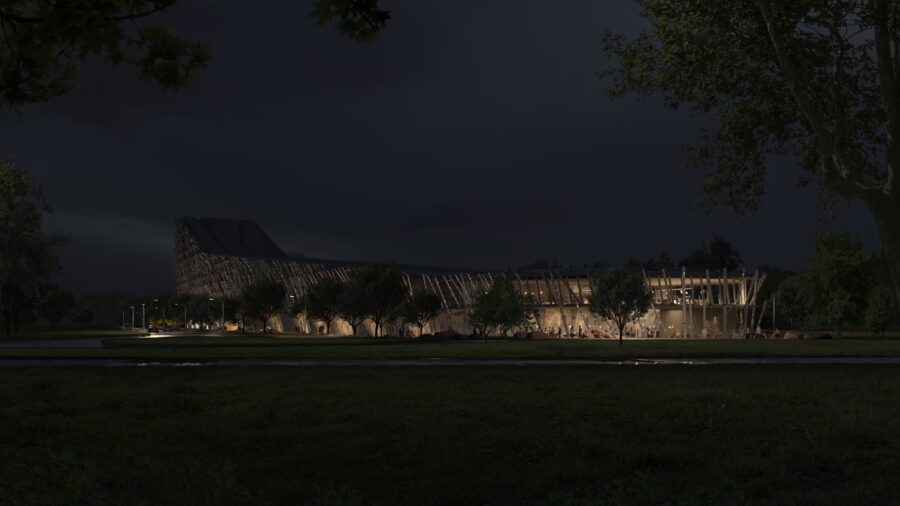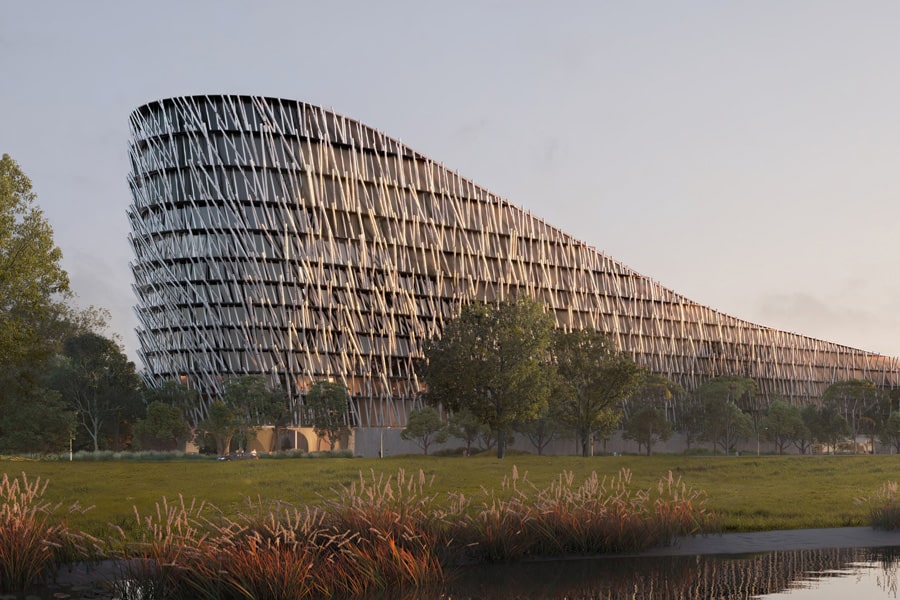Since the century started, US ski areas have come up $5 billion short due to climate change, according to a study in Current Issues in Tourism. Ski seasons now run five to seven days shorter than in the glory years of 1960-1979—and the season could shrink even more depending on the pace of global emissions reductions. The result is increased snowmaking costs and decreased revenues from lift tickets, goods and services. The poor conditions for snow from the sky also make snow from machines less than satisfying for skiers paying exorbitant prices.
The solutions for skiers and snowboarders remain limited. They can either travel to higher elevations and latitudes, turn to other mountain sports or go inside. With Ski Dubai making desert skiing an attraction, the last option isn’t so far-fetched.
Worldwide, the number of indoor ski resorts has grown to 124, from Gensler-designed Big SNOW at the American Dream mall in New Jersey to 10 Design’s Huafa Snow World set for a 2025 launch in Shenzhen, China. Now, Australia is inching closer to offering its own indoor ski area. Winter Sports World (WSW) in Penrith, west of Sydney, recently hurdled a major challenge, gaining approval for its State Significant Development Application (SSDA).


Bluebeam Resource Hub
Browse case studies, watch webinars, and see what’s new with Bluebeam.But how do these giant coolers stack up when it comes to the climate change issues that have led to the need to move indoors in the first place? Let’s look closer at Australia’s entry to see how WSW hopes to integrate sustainability and reduce environmental issues that could impact the continent’s alfresco ski resorts.
Architecture inspired by snow
The $400 million complex, envisioned and developed by lifetime Penrith resident Peter Magnisalis, will include a 300-meter (984-foot) advanced open run, learn-to-ski hills, a snow play area, ice climbing and crevasse rock climbing, a 4.5-star 170-room hotel with conference and function rooms, and restaurants and cafes with slopeside views.
“Australia has a limited snow climate, which is expensive, unpredictable and hard to get to,” Magnisalis said. “Our vision is to have an indoor snow resort located within easy reach of Western Sydney that can offer perfect snow and weather every day of the year.”

Dubbed the “Giant Esky” by locals, the alpine façade designed by boutique firm Collins & Turner was inspired by the “shimmering, ephemeral, kinetic energy of snow clouds above a hill,” according to architect Huw Turner. By integrating night lights to conjure ice shards, the façade evokes a blizzard, while the public area and curved lower-level façade conjure melting ice.
The undulating landscape will feature streams, pathways and plantings. Large 8-meter-high (26-foot) message sticks will mimic melting ice and mountains telling stories of the First Nations people and how they lived on the Dyarubbin (Nepean) River. The latter realizes one of the WSW sustainability themes—a place that celebrates the enduring spirit of country and the longstanding connections of Aboriginal people to this place.
Other themes included in the Ecologically Sustainable Development (ESD) report produced by Atelier Ten, environmental design consultants for the project, include climate action, water conscious, circular economy, biodiverse habitat and welcoming and inclusive. They provide direction for specific targets and design initiatives intended to promote sustainable development.
Sustainability demands of a cooler
The “About Us” on the WSW website states, “We’re proud that we’ll be delivering exceptional sustainability outcomes and meeting top green building benchmarks by applying best practice principles of Environmentally Sustainable Development and responding directly to the local environmental challenges of Penrith and Western Sydney.” The promised outcomes include a facility that is net zero carbon ready, resource efficient, resilient, future climate ready and nature positive.
A significant challenge arises from the need for an energy-efficient environment that keeps heat out and cold in. A well-insulated snow box will be critical to keeping snow in the best condition, reducing snowmaking frequency and minimizing associated energy and water use. WSW will rely on thermal mass to regulate internal temperature.
To meet some of the energy demand, the facility plans to use onsite renewable generation from photovoltaic panels on the roof and daily green energy purchases. “We are confident that the solar panels will cater for up to approximately 60% of the electric energy needs for snowmaking,” Magnisalis said.
Likewise, snowmaking requires water, which WSW plans to collect from the facility’s roof, with snow and ice melt filtered and captured into a grey water tank for irrigation, toilet flushing and other non-potable uses. WSW estimates the water required for the initial ramp-up for snowmaking is 2.5 million liters, around the size of an Olympic swimming pool. Builders will connect a 1.6-million-liter tank to the roof as soon as possible during construction to take advantage of rainfall. Within the snow box, the facility will capture condensation and defrost water and reuse it for snowmaking.
Turning aspirations into actualities
WSW states that the facility has been designed to be net-zero carbon ready by “reducing embodied carbon; eliminating fossil fuel use on-site; minimizing energy use; supplying energy with onsite renewable sources; buying green power for remaining energy needs; and offsetting remaining emissions.”
However, Magnisalis deferred questions about the net zero carbon elements pending completion of the detailed design development phase. Still, he said, “We are confident in achieving these benchmarks.”
That said, in the Atelier Ten ESD report for WSW, the firm made clear “it is imperative that sustainability objectives are backed up by an approach to assurance that gives absolute confidence that the claimed outcomes will be achieved.” The firm said the framework should provide independent review, transparent methodology and accountability at each phase of the lifecycle.

Atelier Ten suggested WSW target a 5-star Green Star Buildings rating for the project, a holistic tool for new buildings and major refurbishments in Australia. As part of the SSDA, Atelier Ten included a building appraisal in the ESD report to demonstrate how WSW can achieve a 5-star rating.
It remains to be seen how environmentally sensitive the facility will actually be when built and operating. But as the project evolves, WSW has an opportunity to meet ambitious goals and demonstrate that this indoor ski model doesn’t contribute to the conditions that made heading indoors intriguing in the first place.











